All about extension cords
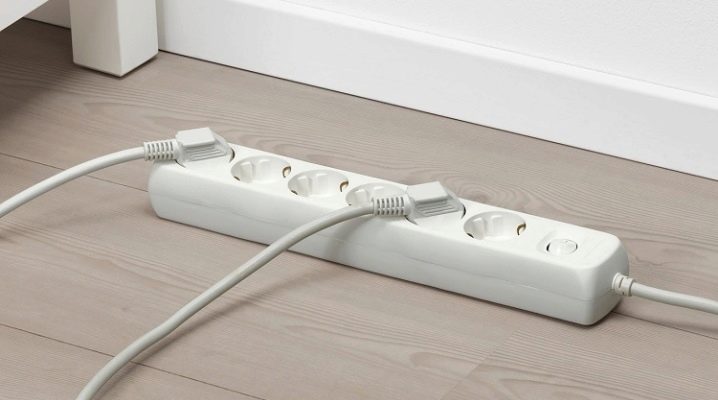
When there are not enough stationary sockets in a house or in an institution, or they are located far from installed household appliances, an electrical extension cord comes to the rescue, presented in a variety of retail chains. Before buying such a simple at first glance, but such an irreplaceable device, you should familiarize yourself with the types of extension cords, their features and the principle of operation.


What it is?
An extension cord is a device that enables household appliances that are remote from stationary outlets to operate by supplying electricity... A small device performs 2 tasks: extension (when the length of the electrical appliance wire is simply not enough) and branching (when there is a shortage of sockets, but it is necessary to connect a coffee maker, hairdryer, microwave oven, mixer). The electrical extension cord has a simple design that includes a housing with protected sockets and a cable with a fixed plug.
Depending on the type of device, its shape and operating potential, the extension cord can be equipped with different elements: automatic fuse, network filtering system, push-button and consumption meter. The variety of models significantly complicates the selection and purchase process, so this should be done by understanding the design and purpose of this or that extension cord.
As practice shows, inexperienced users choose a device solely by the length of the cable and the number of sockets on the case, but this is correct only when carrying is needed to connect a floor lamp or a table lamp, in other cases a more careful and serious approach to the choice is needed.

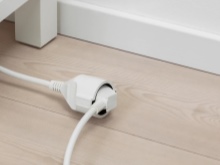

Views
All extension cords, regardless of manufacturer and cost, are classified according to their design features, purpose and packaging, which can help during the purchase of the product. You can also take into account the location method.
- Regular (standard). This is a demanded category of devices used in everyday life in apartments, houses, offices. Such devices have a standard purpose, do not attract attention, and are located so as not to interfere (the cable is hidden in furniture, in the baseboard, under the carpet). Often, computer equipment, TVs, printers are connected to such carriers. The cable length can vary from 1 to 10 m.

- On the frame. A handy device when you need to connect any unit away from a stationary outlet. As a rule, this is an accessory with a socket for 1 socket and an extended cable for 10–20 m, which can be easily wound on a special frame when it is not necessary to use it.

- On a reel... This is a category of devices that are needed during construction, agricultural work. The design is a metal reel for winding a cable, the length of which can reach 100 m, and a stable stand. Sockets are located on the side of the coil. New models of extension cords on a reel have advanced features: self-winding cable, waterproof case, automatic switch and more.
Such a device can be used for partial unwinding of the cable.

- Roulette... This is a convenient and practical reel-in model of an extension cord that looks like a wheel. Sockets-sockets are arranged on the protected case of the product (there are models with 3, 4 connectors).Convenient cable winding and extraction is provided by a special spring-type mechanism. The length of the cord in such structures reaches 3-5 m.

There are several types of power strip according to the method of connecting the cord.
- With a case that is easy to disassemble... The body of the product is connected with screws, screws, which allows for minor repairs: replace the socket or wire. This ensures the durability of the product.
- Unbreakable... The class of one-piece, which cannot be disassembled, includes reel and standard models. On the one hand, there is no possibility of repairing the structure, and on the other hand, access for children's hands is closed, there is protection from moisture and other factors.


If we take into account the safety indicator, then the carriers are divided into 2 classes.
- Devices with a standard systemprotecting against electric shock. This is a carrier with durable parts, secure element mountings and a standard grounding contact.
- Devices with a reinforced protection system, which is more reliable. These are devices with double insulation of the cord and additional protective parts of the structure.
In addition, there are models with standard environmental protection as well as splash and jet resistant models. If an extension cord is used indoors, then a sufficient level of protection is IP20, and for devices used outdoors - IP44.


It is also necessary to pay attention to the configuration, design, equipment with innovative technologies.... Among the demanded models offered by manufacturers, one can single out extension cords with a shutdown timer for 3 sockets, devices with a soft start. Incredibly convenient and practical, especially for offices and other premises, is a tabletop corner device with two or three sockets, as well as a tee-extension (splitter), which consists of different sockets-sockets (there are models for 6, 8 sockets).
If the design is taken into account, then you can choose the device by color: black, white, gray and even transparent - a special extension cord for the LED garland. There are 3 types of extension cords according to the method of use and installation.


Portable
Carriers are popular models of various configurations that can be used in the right place. They are compact, easy to operate and reliable. The weight of even the largest devices does not exceed 12-15 kg.
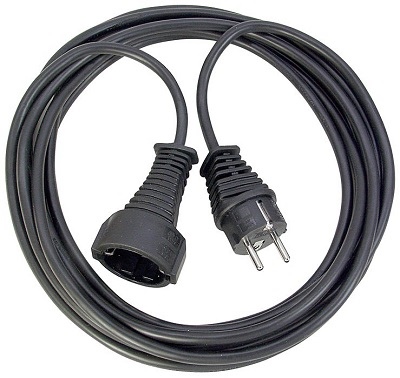
Stationary models
These are powerful constructions, not moving from place to place, that is, they are installed permanently. Most of these models are quite heavy, their weight can exceed 15 kg. A characteristic feature of stationary structures is the fastening mechanism.

Retractable
These are modern, recently introduced devices. Innovative pull-out designs are usually built into the kitchen countertop, office table or closet... They are found in horizontal and vertical types. The built-in retractable extension is equipped with a protective and masking cover, as well as additional connectors: HDMI, USB, Internet, thanks to which the device is called universal.

Applications
Extension cords, like power tools and numerous electrical appliances, are offered for use both at home and for use on a large scale construction or production. That is why manufacturers classify them into household and professional ones.


Household
A household or home extension cord is a popular model with a cable length of up to 10 m and a conductor cross-section of 0.5–1.5 mm 2. In turn, these extension cords are:
- low-power - up to 1 kW;
- with an average power level (1–2.2 kW);
- powerful - above 2.5 kW.


Professional
A professional or construction extension cord is a design used on construction sites, in production, in various large-scale projects using powerful electrical units. It is characterized by a conductor cross-section of up to 2–2.5 mm 2 and a cord length of up to 50–60 m. In addition, such devices are well equipped: there is protection against splashes and moisture, voltage surges, and unplanned cable unwinding.
If you use the carrier for other purposes, then it will quickly fail. In addition, there is a risk of fire, short circuits, breakdown of connected electrical appliances.


Types of forks
When deciding on the number of sockets in the carrier, you should pay attention to the type of plugs. Plugs, as a rule, are cast and collapsible (detachable), however, the first option is the most durable and reliable, since such a design is safer, it is difficult to make it by handicraft... On the territory of our country, plugs of type C (outdated standard) and F (European standard) are widely used. EU plugs have a pair of grounding plates.
Most of the equipment on the market is equipped with a grounded plug, which does not imply interaction with old-style sockets. In cases of mismatch, adapters are used or the outlet is changed. Among the new products in this segment are extension cords with flat plugs. Such models are ergonomic, easy to use, suitable for sockets in hard-to-reach places.
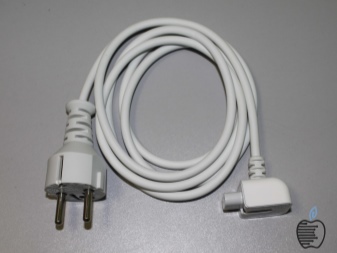

Dimensions (edit)
The length of the extension cord may vary. On sale you can find a device with a cable from 1 to 50 m.If you choose a household (home) appliance, then 5 m is enough, in some cases - 10 m, the main thing is that the cord is not too short, not stretched during operation. If you need a professional device for construction or welding, you should think about models with a long cord (50-60 m). Some manufacturers offer reel-to-reel designs with cord lengths up to 100 m.
When using devices with a long cable, it is necessary to control its position, since the cord must be unwound so that overheating and knotted weaves do not occur, which can lead to mechanical damage.


How to choose the right one?
When buying an extension cord for the kitchen, which is full of household appliances, or for the study, where there is a computer and other devices, it will be advisable to use important selection criteria.
- Number of socket outlets. For home use, an extension cord for 1–4 sockets is sufficient.
- Safety grounding contact... In the event of a malfunction of the connected device, the grounding system can prevent electric shock to the user.
- Length of cable. The cord should not be too stretched, but an excess of 3-5 m is not needed, since electricity is wasted.
- The level of the permissible load. It is necessary to determine which household appliances will be connected through the extension cord. For a computer or TV, a device with a capacity of up to 1.3 kW is enough, and for a dishwasher to work, you will need a carrier with an indicator of up to 2.2 kW. For construction and agricultural work, a powerful device is needed.
- Equipment: Is there a circuit breaker system that prevents voltage surges and interruptions.
- The quality of the cable insulation. For a house or apartment with a normal temperature, a model with single-layer insulation is suitable, and for outdoor use it is better to choose a device with two-layer insulation.
- It will be useful to pay attention on auxiliary elements, as well as on the manufacturer of the device.
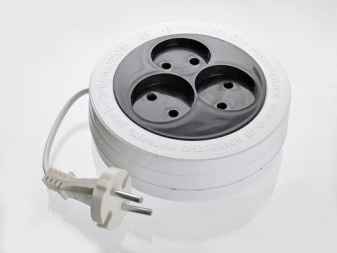

Popular models
Taking into account the feedback from users, a small rating of manufacturers was compiled, whose extension cords proved to be excellent in operation, are of high quality, reliable and affordable. The list includes manufacturers offering the best extension cords: APC, Defender, Sven, Pilot, Xiaomi. Many users note the high build quality and ease of use of some models.
- Navigator NPE-USB-05-180-ESC-3X1.0, ideal for home use, equipped with a robust plastic housing and 180 cm cable. The model has 5 grounded sockets and 2 USB sockets, as well as a switch.

- PowerCube PC-LG5-R-30 - It is a powerful extension cord on a frame with an oversized cord (30 meters) and 5 slots.The design is equipped with a switch with indicator light and double-braided cable.

- APC PM5-RS, equipped with 5 outlets, 180 cm cable and surge protection system. If desired, the device can be hung on the wall.
Ratings of high-quality and proven models, as well as real customer reviews, can help you choose the most convenient and reliable device in operation.

Operating rules
In order for the device to serve for a long time and safely, without violating the integrity of devices and electrical wiring, elementary operating rules must be observed.
- Do not modify the device yourself, trying to improve or make it more functional... Mechanical intervention in the design of the device can lead to its breakdown and fire.
- Upon completion of work be sure to disconnect the appliance from the mains. A carrier is an instrument for temporary use.
- Handle the cable carefullyto avoid mechanical damage and other damage to the integrity. The broken cord must be securely insulated with a special tape or replaced with a new one.
- Do not twist the cable randomly or into knots... This can lead to its defects and failure of the extension cord as a whole.
- Do not connect household appliances to the carrier that will overload the carrier. For powerful units and electrical appliances, it is recommended to use special-purpose extension cords.
- In addition, it is forbidden to use an extension cord in a coiled state in order to avoid overheating of the wire, and under no circumstances connect the device in an open area during bad weather - rain or snow.
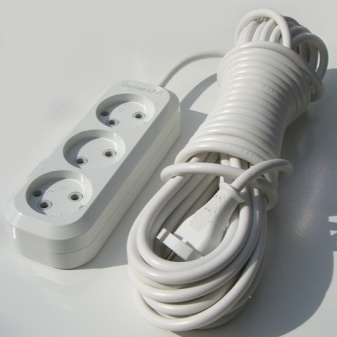














The comment was sent successfully.